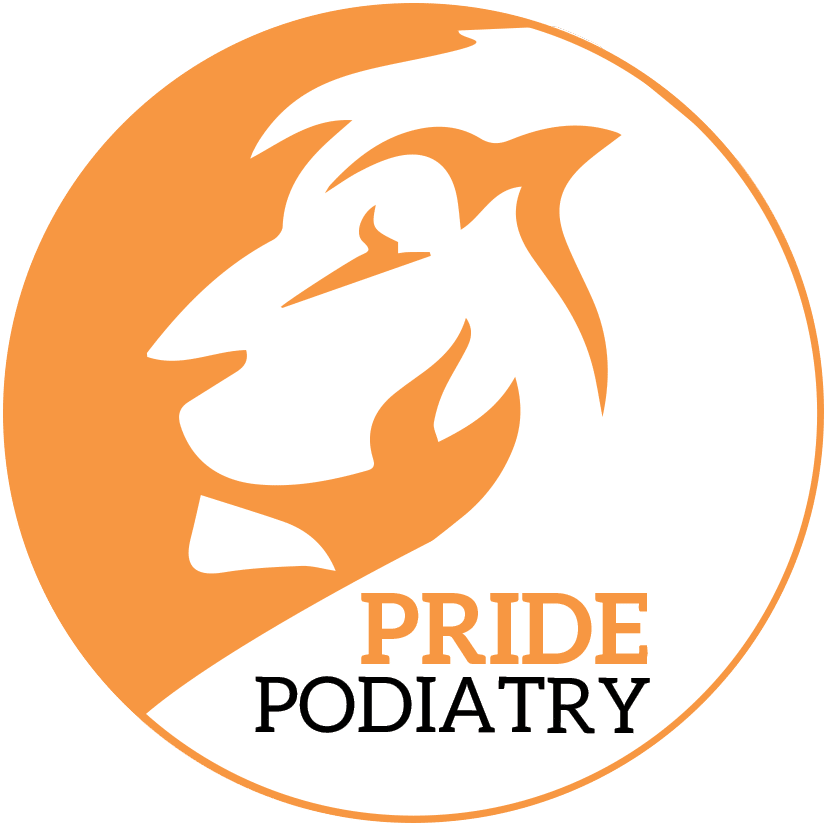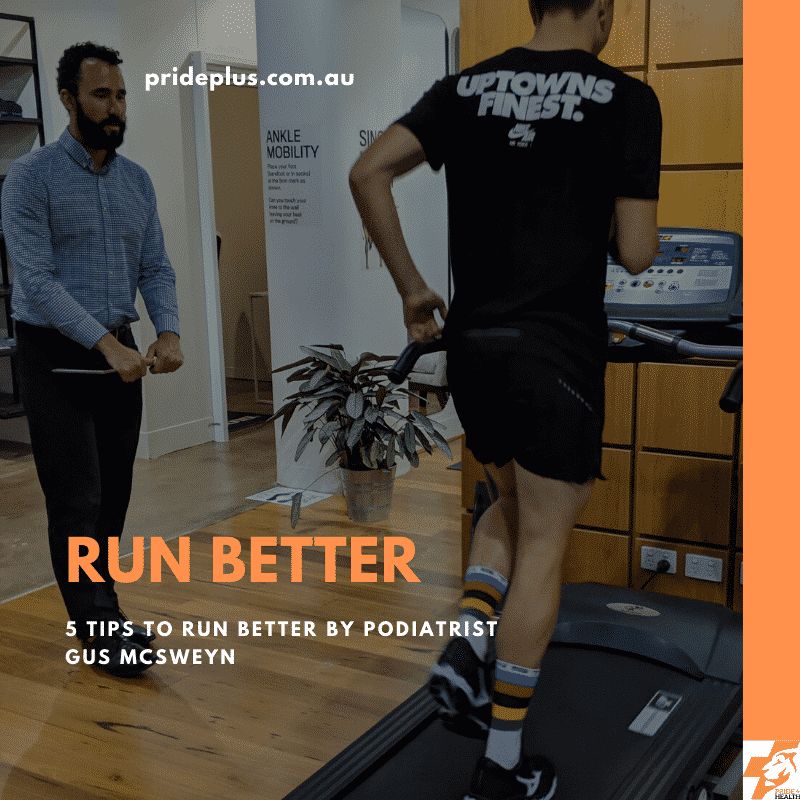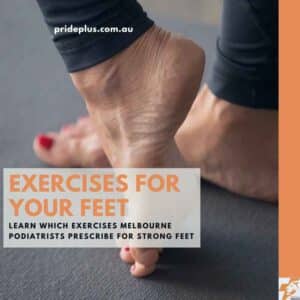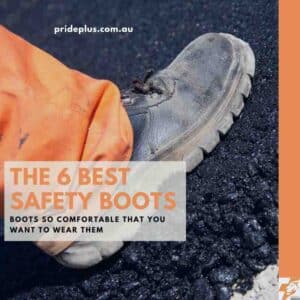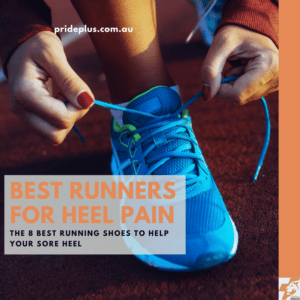Here are 5 easy to implement strategies to run better. Let me help you prevent injury and improve performance.
Quick intro – My name is Gus McSweyn. I’m a podiatrist here at PridePlus Health. I love running, and having worked with elite, sub elite and recreational athletes throughout my practice, I have developed a special interest running better. I’m also a runner myself, play semi-professional sport and currently practice in an environment that most podiatrists would only dream of.
Tip 1 to run better: Strength
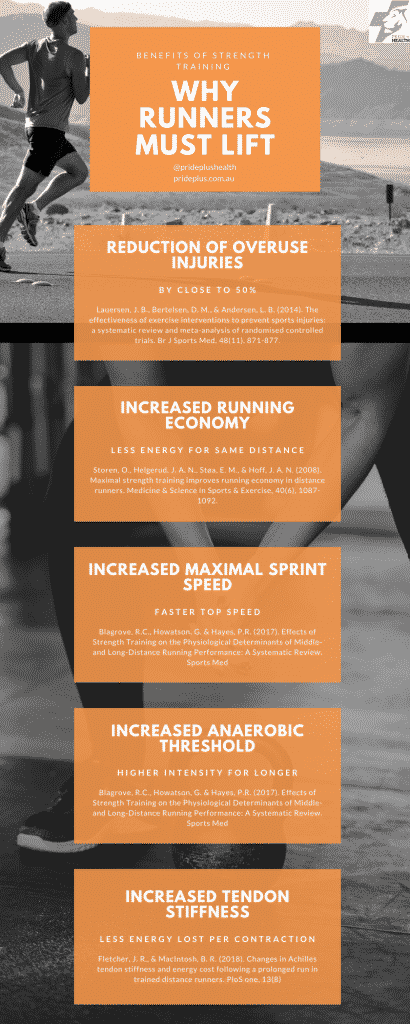
The evidence for strength training to run better is becoming more and more apparent. Implementing strength based training into your routine is extremely beneficial for every runner of every shape, size and distance (1). These benefits start at reducing the incidence and risk of injury, and cumulate into improved running economy and and better running performance (ie, faster times!) (2). And who doesn’t want all of the above?
To begin, I would implement these 3 easy to complete exercises. They are great because no heavy weights or gym memberships are required initially.
- A single leg straight knee calf raise
- Stand on one foot at a time, slowly rise onto your toes, hold and lower. Careful not to wobble or lean from side to side. Keep that knee locked back and extended.
- Single leg bent knee calf raise
- The same position as above, but keep your knee in a flexed or bent position for the rise onto your toes.
- One legged sit to stand
- Start sitting on a chair and go to stand up, but only have one foot on the ground. You can extend your other leg in front of you to aid balance.
Tip 2 to run better: Footwear (Find your ‘Perfect Fit’)
The ever eternal question, what are the best running shoes? There are so many shoe options, from what seems like millions of different brands. Cushioned, lightweight, support, control, those glove shoes?? Picking the right pair can be very very daunting.
Thankfully we are here to help make this process not only an enjoyable and fun experience but also educational and empowering. Let me introduce you to Perfect Fit- running shoe fitting by a podiatrist.
The science of running shoe selection is complex and individual. For many of us the mechanical design of a shoe is an important factor in the battle to overcome a running injury. It can be the difference between you being able to run or not.
So if you are currently struggling with an injury impeding your performance or unsure of which is the best running shoe for you. Book in for a footwear & biomechanical assessment and get your Perfect Fit.
Tip 3 to run better: Variety (it’s the spice of life)
Due to the repetitive nature of running itself (ie. one foot after the other coming in contact with the ground for a prolonged period of time) certain areas are constantly asked to do high levels of work.
Pair this with the habitual nature of runners. Quick test for runners out there, do you always head out the front door and turn left? Yeah, we all do! Us runners are typically running the same tracks, on the same surfaces for the same distances and speeds week in, week out. It is no surprise that we have a recipe that serves up overuse injuries.
Some great research by Nielsen et al., 2012 found that per 1000 hrs of running the likelihood of suffering a running related injury was as high as 85% (3).
To help combat this and give you a better run, implementing variation within your training schedule is essential. This could include on Monday instead of going for a 30min jog on the road, do a 30min jog through a trail; or instead of doing 10km session at race pace, try a 5x1km interval session with 1min recovery between sets.
Or next time you head out the front door to start running. Become an ambiturner. Turn right.
Tip 4 to run better: Programming
Following on from variety, having a structured, but varied running program is an essential tool in the armory of a runner looking to run better. Having a running program of what your upcoming week and month looks like helps with two things. One, you’ll be able to visualise and build towards your goal. And two, most importantly, will help avoid training errors such as the all to common “too much too soon”. This ultimately assists you in running better by reducing your injury risk and allowing you to get the most out of training and rest periods.
There are alot of generalised programs around and these can be really effective in providing a basis for your build up to an event. But remember these are a base, and like most things in life there is no “one size fits all solution”, so for your specific goals alteration may be required.
My preferred option to running better is a personalised program structured by a running coach. These programs will be based on your individual goals, current conditioning and injury history. You’ll work stride for stride, hand in hand with an expert to plan the perfect build up into your event.
A running program isn’t essential for everyone, however if this is something that you would like to look into, calling on the coaches at Runfix coaching in Melbourne will help you map your journey to better running!
Tip 5 to run better: Rest
An underrated aspect of life, rest is absolutely crucial to running better. We absolutely must allow our body appropriate rest, got it? It is the ever present battle of increasing the loads/stress/work of the muscles, tendons and bones to make them bigger/stronger/more efficient and allowing them sufficient time to be able to recover and allow for these structures to be able to repair and grow.
An essential aspect of this is listening to your body. If you are sore or tired, that is our bodies way of saying it needs a little longer to run better. Having a lighter session or taking the day off now isn’t going to ultimately harm your overall training, however an injury will.
So next week or next run, try implementing one or two of these tips into you routine or look into getting a high-skilled assistant on your team and let’s watch those PB’s come sprinting through.
Happy running!
References
- Karsten, B., Stevens, L., Colpus, M., Larumbe-Zabala, E., & Naclerio, F. (2016). The effects of sport-specific maximal strength and conditioning training on critical velocity, anaerobic running distance, and 5-km race performance. International journal of sports physiology and performance, 11(1), 80-85.
- Storen, O., Helgerud, J. A. N., Støa, E. M., & Hoff, J. A. N. (2008). Maximal strength training improves running economy in distance runners. Medicine & Science in Sports & Exercise, 40(6), 1087-1092.
- Nielsen, R. O., Buist, I., Sørensen, H., Lind, M., & Rasmussen, S. (2012). Training errors and running related injuries: a systematic review. International journal of sports physical therapy, 7(1), 58.
